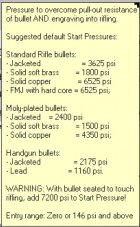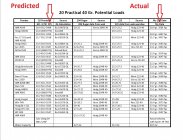I'm returning to a question I raised over a year ago on this forum--but with a slight change. I've been experimenting with QuickLoad in connection with my .270 Win. and have found big differences in estimated pressures and muzzle velocities when the Shot Start (Initialization) Pressure is set at the default value of 3625 as opposed to when it is set to account for bullets seated close to the lands. The QL instructions say that you should add 7200 to the 3625 (i.e., use the value 10,825) for bullets seated to actually touch the lands. Then subtract 29 for each .001” seated off the lands. So as an example, with my .270 Win with bullets seated with a .030” jump (.030” off the lands), I would subtract 870 (29 x 30) from the 10,825 for a value of 9955 as the Shot Start (Initialization) Pressure. I should note that there are some guys who suggest that you should use the default value of 3625 for any jump. When I run QL for my .270 Win., I get very different pressure values and velocities when I use the 3625 value as opposed to when I use the adjusted value of 9955.
So here's my question: Do you guys who have been using QL and chronographing your loads find that you get the best agreement between what QL says and what your chronograph says
(a) when using the default value (3625) for the Shot Start Pressure or
(b) when you adjust that for closeness to the lands, in which case the Shot Start Pressure you enter will be much greater than 3625 as shown above?
So here's my question: Do you guys who have been using QL and chronographing your loads find that you get the best agreement between what QL says and what your chronograph says
(a) when using the default value (3625) for the Shot Start Pressure or
(b) when you adjust that for closeness to the lands, in which case the Shot Start Pressure you enter will be much greater than 3625 as shown above?
Last edited:












